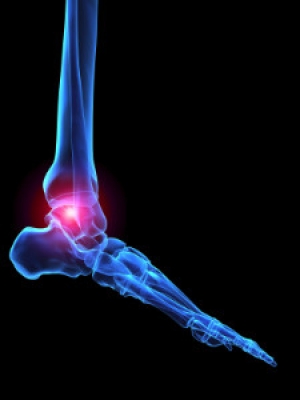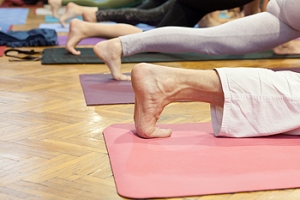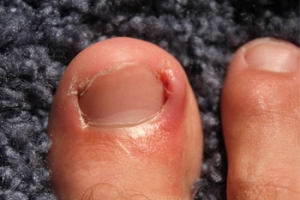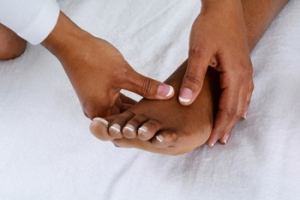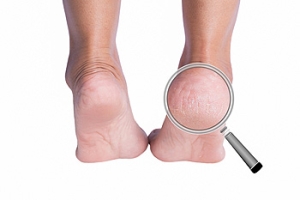Connect With Us
Blog

Common Symptoms That Are Associated With Rheumatoid Arthritis
 The medical condition that is known as rheumatoid arthritis (RA) can cause the patient to experience pain and discomfort, in addition to having deformed toes. It may be difficult to stand for extended periods of time, and the feet can ache for the majority of the day. The joints often become weak, which can be a result of tissue, bone, and cartilage breaking down. A common symptom is swelling, and patients may find it difficult to complete daily activities. The feet may change shape, and larger shoes may have to be worn that can accommodate the changing foot. Patients who are afflicted with RA can find relief when the feet are elevated, and it may feel better to soak the feet in warm water. If you have symptoms of rheumatoid arthritis in the feet, it is strongly advised that you consult with a podiatrist who can help you to manage this condition.
The medical condition that is known as rheumatoid arthritis (RA) can cause the patient to experience pain and discomfort, in addition to having deformed toes. It may be difficult to stand for extended periods of time, and the feet can ache for the majority of the day. The joints often become weak, which can be a result of tissue, bone, and cartilage breaking down. A common symptom is swelling, and patients may find it difficult to complete daily activities. The feet may change shape, and larger shoes may have to be worn that can accommodate the changing foot. Patients who are afflicted with RA can find relief when the feet are elevated, and it may feel better to soak the feet in warm water. If you have symptoms of rheumatoid arthritis in the feet, it is strongly advised that you consult with a podiatrist who can help you to manage this condition.
Because RA affects more than just your joints, including the joints in your feet and ankles, it is important to seek early diagnosis from your podiatrist if you feel like the pain in your feet might be caused by RA. For more information, contact one of our podiatrists of Family Foot Care of Long Island. Our doctors will assist you with all of your podiatric concerns.
What Is Rheumatoid Arthritis?
Rheumatoid Arthritis (RA) is an autoimmune disorder in which the body’s own immune system attacks the membranes surrounding the joints. Inflammation of the lining and eventually the destruction of the joint’s cartilage and bone occur, causing severe pain and immobility.
Rheumatoid Arthritis of the Feet
Although RA usually attacks multiple bones and joints throughout the entire body, almost 90 percent of cases result in pain in the foot or ankle area.
Symptoms
- Swelling and pain in the feet
- Stiffness in the feet
- Pain on the ball or sole of feet
- Joint shift and deformation
Diagnosis
Quick diagnosis of RA in the feet is important so that the podiatrist can treat the area effectively. Your doctor will ask you about your medical history, occupation, and lifestyle to determine the origin of the condition. Rheumatoid Factor tests help to determine if someone is affected by the disease.
If you have any questions please feel free to contact our office located in Port Jefferson Station, NY . We offer the newest diagnostic and treatment technologies for all your foot and ankle needs.
Rheumatoid Arthritis in the Feet
Rheumatoid Arthritis is a chronic progressive disease that attacks several joints throughout the body. It is an autoimmune disease in which the body’s immune system mistakenly attacks the joints. As a result, the tissue inside the joints, called synovium, starts to thicken and causes pain around the joints. The synovium is responsible for creating a fluid that lubricates the joints to help them move. Approximately 1.5 million people in the United States have Rheumatoid Arthritis. Women are almost three times as likely to have RA compared to men, and it’s disease usually begins between the ages of 30 and 60. People who have a genetic history of RA are more likely to develop the disease.
Symptoms of RA may include the following sensations in the joints: pain, tenderness, swelling, redness, warmth, stiffness, and loss of range. Swollen joints are a very common symptom for those with the disease. At times, it may be minimal, but it may also be very apparent. Another typical symptom is joint stiffness. Doctors will often use the direction of morning stiffness to measure the severity of a patient’s joint inflammation. Other RA symptoms include limping, anemia, fever, and fatigue.
To diagnose RA, your podiatrist will typically request x-rays to see how much damage there is in the joints. Blood tests may also be performed to show if there are any signs of anemia, or antibodies such as the rheumatoid factor. If you have previously been diagnosed with RA, you should know the disease may spread to your feet and ankles.
There are many non-surgical options that can be used to treat this ailment. Some of these options include physical therapy, foot massages, orthotics, bracing, supportive shoes, and steroid injections. Physical therapy is useful because it will help stretch and strengthen the joints in both the foot and ankle to improve joint function. Massages can help improve blood circulation which will be good for the feet. Choosing proper footwear will allow you to walk with comfortability if you are a sufferer from RA. Lastly, bracing will help stabilize the foot joints, limit deformities and decrease pain.
In severe cases, surgery may be a treatment option that should be considered. For those who cannot walk without experiencing pain and those whose deformities can not be managed with braces, surgery should be considered. Your podiatrist will recommend surgery if he or she believes it will improve your foot biomechanics.
Toe Stretches May Help Foot Conditions
 Many people enjoy the feeling of stretching their feet. Stretching helps the overall foot to feel good, in addition to improving mobility and flexibility. There are specific stretches that are suggested for certain foot conditions such as bunions and plantar fasciitis. The plantar fascia is the portion of tissue which connects the heel to the toes, and it is located on the bottom of the foot. It may become stronger when the toes are pointed and flexed, or when the sole of the foot is rolled on a bottle. Bunions may be caused by wearing shoes that do not have adequate room for the toes to move freely in. It is beneficial to place the ankle across the opposite thigh, and gently rotate the toes to each side. When patients stand for the majority of the day, the toes may become cramped and stiff, and existing discomfort may be relieved when the toes are stretched. For additional information about how to properly perform foot stretches, please consult with a podiatrist.
Many people enjoy the feeling of stretching their feet. Stretching helps the overall foot to feel good, in addition to improving mobility and flexibility. There are specific stretches that are suggested for certain foot conditions such as bunions and plantar fasciitis. The plantar fascia is the portion of tissue which connects the heel to the toes, and it is located on the bottom of the foot. It may become stronger when the toes are pointed and flexed, or when the sole of the foot is rolled on a bottle. Bunions may be caused by wearing shoes that do not have adequate room for the toes to move freely in. It is beneficial to place the ankle across the opposite thigh, and gently rotate the toes to each side. When patients stand for the majority of the day, the toes may become cramped and stiff, and existing discomfort may be relieved when the toes are stretched. For additional information about how to properly perform foot stretches, please consult with a podiatrist.
Why Stretching Is Important for Your Feet
Stretching the feet is a great way to prevent injuries. If you have any concerns with your feet consult with one of our podiatrists from Family Foot Care of Long Island. Our doctors will assess your condition and provide you with quality foot and ankle treatment.
Stretching the Feet
Stretching the muscles in the foot is an important part in any physical activity. Feet that are tight can lead to less flexibility and make you more prone to injury. One of the most common forms of foot pain, plantar fasciitis, can be stretched out to help ease the pain. Stretching can not only ease pain from plantar fasciitis but also prevent it as well. However, it is important to see a podiatrist first to determine if stretching is right for you. Podiatrists can also recommend other ways to stretch your feet. Once you know whether stretching is right for you, here are some excellent stretches you can do.
- Using a foam roller or any cylindrical object (a water bottle or soda can will do), roll the object under your foot back and forth. You should also exert pressure on the object. Be sure to do this to both feet for a minute. Do this exercise three times each.
- Similar to the previous exercise, take a ball, such as a tennis ball, and roll it under your foot while seated and exert pressure on it.
- Grab a resistance band or towel and take a seat. If you are using a towel, fold it length wise. Next put either one between the ball of your foot and heel and pull with both hands on each side towards you. Hold this for 15 seconds and then switch feet. Do this three times for each foot.
- Finally hold your big toe while crossing one leg over the other. Pull the toe towards you and hold for 15 seconds. Once again do this three times per foot.
It is best to go easy when first stretching your foot and work your way up. If your foot starts hurting, stop exercising to ice and rest the foot. It is advised that you then see a podiatrist for help.
If you have any questions, please feel free to contact our office located in Port Jefferson Station, NY . We offer the newest diagnostic and treatment technologies for all your foot care needs.
Stretching Your Feet
Debilitating foot pain is a problem for many people. But just as stretching the torso can help alleviate back pain, stretching the feet can also help mend existing foot problems and prevent future ones.
The feet, as the body’s foundation, carry the body’s entire weight and can get easily strained from overexertion. Persistent sharp pain and cramping in the feet are often common concerns. Foot pain and foot problems can be due to any number of causes, and in many cases pain may be eased without medication or doctor visits. It is always a good idea, however, to first rule out any serious medical issues with a physician.
Stretching can help relax the feet and alleviate pain, but is especially important before heavy aerobic exercise. Stretching before such activities can help you avoid experiencing painful cramps or strained foot muscles. Stretches should be performed slowly and deliberately without forceful pulling. The stretch should be held for several seconds before relaxing.
A great way to stretch out and loosen up the foot muscles while sitting is to cross one leg over the other and pull the toes carefully back without overextending. Start by resting the left ankle on the right knee. With the left hand, gently flex the left foot by pulling back on the toes. Do not pull too hard; just hard enough to feel the stretch in the arch of the foot. Then point the toes of the left foot as far as you can. Rotate the motion of pointing with pulling back on the toes. This should relax and stretch the muscles on the bottom and the top of the foot. Doing this stretch ten to twenty times should bring relief. Repeat the whole process for the other foot by resting the right ankle on the left knee.
A stretch that focuses on the often injured Achilles tendon involves standing and facing a wall with your arms out and hands flat against the wall. Step back with one foot, keeping it flat against the floor. Move the other leg forward and lean toward the wall. You should feel a stretch through the back of your leg and your Achilles tendon, but do not push yourself too much. Stop when you feel a stretching sensation, and hold for 30 seconds. Ten repetitions may be done for each foot.
Stretching the feet is important for athletes or those performing aerobic exercise, but it can also help anyone with foot pain caused by poor footwear, plantar fasciitis, or long hours standing and walking. Individuals who tend to their feet by regularly stretching every day should be able to minimize foot pain and prevent new problems from arising.
Possible Reasons Why an Ingrown Toenail May Develop
 The medical term for a common foot condition that is known as ingrown toenails is referred to as onychocryptosis. It is a painful ailment that develops as a result of the outer edges of the toenail growing into the surrounding skin. The symptoms that often accompany an ingrown toenail often include redness and swelling. Additionally, if the impacted area becomes infected, there may be a discharge. Ingrown toenails may develop for a variety of reasons. These can include trimming the toenails incorrectly, wearing shoes that do not fit properly, and having an existing medical condition such as diabetes. Many patients have found mild relief when the toe is soaked in warm water, as this may help to soften the edges of the nail. If you are afflicted with an ingrown toenail, it is suggested that you speak with a podiatrist who can guide you toward the correct treatment options.
The medical term for a common foot condition that is known as ingrown toenails is referred to as onychocryptosis. It is a painful ailment that develops as a result of the outer edges of the toenail growing into the surrounding skin. The symptoms that often accompany an ingrown toenail often include redness and swelling. Additionally, if the impacted area becomes infected, there may be a discharge. Ingrown toenails may develop for a variety of reasons. These can include trimming the toenails incorrectly, wearing shoes that do not fit properly, and having an existing medical condition such as diabetes. Many patients have found mild relief when the toe is soaked in warm water, as this may help to soften the edges of the nail. If you are afflicted with an ingrown toenail, it is suggested that you speak with a podiatrist who can guide you toward the correct treatment options.
Ingrown toenails may initially present themselves as a minor discomfort, but they may progress into an infection in the skin without proper treatment. For more information about ingrown toenails, contact one of our podiatrists of Family Foot Care of Long Island. Our doctors can provide the care you need to keep you pain-free and on your feet.
Ingrown Toenails
Ingrown toenails are caused when the corner or side of a toenail grows into the soft flesh surrounding it. They often result in redness, swelling, pain, and in some cases, infection. This condition typically affects the big toe and may recur if it is not treated properly.
Causes
- Improper toenail trimming
- Genetics
- Improper shoe fitting
- Injury from pedicures or nail picking
- Abnormal gait
- Poor hygiene
You are more likely to develop an ingrown toenail if you are obese, have diabetes, arthritis, or have any fungal infection in your nails. Additionally, people who have foot or toe deformities are at a higher risk of developing an ingrown toenail.
Symptoms
Some symptoms of ingrown toenails are redness, swelling, and pain. In rare cases, there may be a yellowish drainage coming from the nail.
Treatment
Ignoring an ingrown toenail can have serious complications. Infections of the nail border can progress to a deeper soft-tissue infection, which can then turn into a bone infection. You should always speak with your podiatrist if you suspect you have an ingrown toenail, especially if you have diabetes or poor circulation.
If you have any questions, please feel free to contact our office located in Port Jefferson Station, NY . We offer the newest diagnostic and treatment technologies for all your foot care needs.
Ingrown Toenails
An ingrown toenail is a nail that has curved downward and grown into the skin. This typically occurs at either the nail borders or the sides of the nail. As a result, pain, redness, swelling, and warmth may occur in the toe. If a break in the skin forms due to the ingrown nail, bacteria may enter and cause an infection in the area; this is typically characterized by a foul odor and drainage.
Ingrown toenails have multiple reasons for developing. In many instances, the condition is a result of genetics and is inherited. The most common cause, however, is improper trimming; cutting the toenails too short forces the skin beside the nail to fold over. An ingrown toenail can also develop due to trauma, such as stubbing the toe, having an object fall on the toe, or participating in activities that involve repeated kicking or running. Wearing shoes that are too tight or too short can also cause ingrown toenails.
Treatment for an ingrown toenail varies between patients and the severity of the condition. In most cases, it is best to see your podiatrist for thorough and proper treatment. After examining your toe, your podiatrist may prescribe oral antibiotics to clear the infection if one is present. Surgical removal of either a portion of the nail or the entire nail may also be considered. In some cases, complete removal or destruction of the nail root may be required. Most patients who undergo nail surgery experience minimal pain afterward and can return to normal activity the following day.
Ingrown toenails can be prevented with proper nail trimming and by avoiding improper-fitting shoes. When cutting the toenails, be sure that you are cutting in a straight line and avoid cutting them too short. Shoes should not be too short or tight in the toe box.
Different Types of Foot Pain
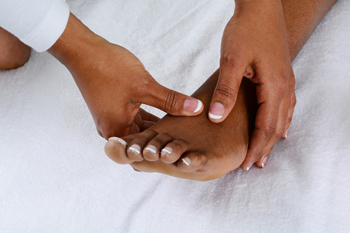 There are several areas in the foot that can feel pain due to specific conditions that may have developed. Heel pain may be indicative of plantar fasciitis and heel spurs, and can cause severe discomfort. Toe pain may signify a bunion, hammertoe, or the arthritic condition that is referred to as gout. A nerve condition that is known as Morton’s neuroma may cause pain in the area between the third and fourth toes, and can be caused by wearing shoes that do not have adequate room for the toes to move freely in. If you are afflicted with any type of foot pain, it is strongly advised that you are under the care of a podiatrist who can diagnose and treat various foot and ankle disorders.
There are several areas in the foot that can feel pain due to specific conditions that may have developed. Heel pain may be indicative of plantar fasciitis and heel spurs, and can cause severe discomfort. Toe pain may signify a bunion, hammertoe, or the arthritic condition that is referred to as gout. A nerve condition that is known as Morton’s neuroma may cause pain in the area between the third and fourth toes, and can be caused by wearing shoes that do not have adequate room for the toes to move freely in. If you are afflicted with any type of foot pain, it is strongly advised that you are under the care of a podiatrist who can diagnose and treat various foot and ankle disorders.
Foot Pain
Foot pain can be extremely painful and debilitating. If you have a foot pain, consult with one of our podiatrists from Family Foot Care of Long Island. Our doctors will assess your condition and provide you with quality foot and ankle treatment.
Causes
Foot pain is a very broad condition that could be caused by one or more ailments. The most common include:
- Bunions
- Hammertoes
- Plantar Fasciitis
- Bone Spurs
- Corns
- Tarsal Tunnel Syndrome
- Ingrown Toenails
- Arthritis (such as Gout, Rheumatoid, and Osteoarthritis)
- Flat Feet
- Injury (from stress fractures, broken toe, foot, ankle, Achilles tendon ruptures, and sprains)
- And more
Diagnosis
To figure out the cause of foot pain, podiatrists utilize several different methods. This can range from simple visual inspections and sensation tests to X-rays and MRI scans. Prior medical history, family medical history, and any recent physical traumatic events will all be taken into consideration for a proper diagnosis.
Treatment
Treatment depends upon the cause of the foot pain. Whether it is resting, staying off the foot, or having surgery; podiatrists have a number of treatment options available for foot pain.
If you have any questions, please feel free to contact our office located in Port Jefferson Station, NY . We offer the newest diagnostic and treatment technologies for all your foot care needs.
Foot Pain
The feet, being the foundation of the body, carry all of the body’s weight and are therefore prone to experiencing pain and discomfort. If you are experiencing foot pain, it is important to determine where in the foot you are experiencing this pain to help discover the cause of it. While pain can be experienced virtually anywhere in the foot, the most common sites of foot pain are in the heel and ankle.
Heel pain can be due to a multitude of conditions including plantar fasciitis, Achilles tendinitis, and heel spurs. Pain experienced in the ankle can be a sign of an ankle sprain, arthritis, gout, ankle instability, ankle fracture, or nerve compression. In more serious cases, pain in the foot can be a sign of improper alignment or an infection.
Foot pain can be accompanied by symptoms including redness, swelling, stiffness and warmth in the affected area. Whether the pain can be described as sharp or dull depends on the foot condition behind it. It is important to visit your local podiatrist if your foot pain and its accompanying symptoms persist and do not improve over time.
Depending on the location and condition of your foot pain, your podiatrist may prescribe certain treatments. These treatments can include but are not limited to prescription or over-the-counter drugs and medications, certain therapies, cortisone injections, or surgery.
If you are experiencing persistent foot pain, it is important to consult with your foot and ankle doctor to determine the cause and location. He or she will then prescribe the best treatment for you. While milder cases of foot pain may respond well to rest and at-home treatments, more serious cases may take some time to fully recover.
Prompt Treatment Needed for Cracked Heels
 The medical condition that is known as cracked heels can be uncomfortable and unsightly. Common signs of this ailment can include visible cracks in the skin, in addition to thick and peeling skin. It may occur as a result of wearing shoes that have an open back, or from standing for long periods of time throughout the day. Existing medical conditions that can include psoriasis, diabetes, and eczema may play a significant role in developing this condition. It may be beneficial to stay as hydrated as possible, and mild relief may be found when a good moisturizer is frequently applied. Cracked heels can become infected if they are not promptly treated. If you notice symptoms of this condition, it is suggested that you consult with a podiatrist who can determine what the best treatment is for you.
The medical condition that is known as cracked heels can be uncomfortable and unsightly. Common signs of this ailment can include visible cracks in the skin, in addition to thick and peeling skin. It may occur as a result of wearing shoes that have an open back, or from standing for long periods of time throughout the day. Existing medical conditions that can include psoriasis, diabetes, and eczema may play a significant role in developing this condition. It may be beneficial to stay as hydrated as possible, and mild relief may be found when a good moisturizer is frequently applied. Cracked heels can become infected if they are not promptly treated. If you notice symptoms of this condition, it is suggested that you consult with a podiatrist who can determine what the best treatment is for you.
Cracked heels are unsightly and can cause further damage to your shoes and feet. If you have any concerns, contact one of our podiatrists from Family Foot Care of Long Island. Our doctors can provide the care you need to keep you pain-free and on your feet.
Cracked Heels
Cracked heels appear unappealing and can make it harder for you walk around in sandals. Aside from looking unpleasant, cracked heels can also tear stockings, socks, and wear out your shoes. There are several methods to help restore a cracked heel and prevent further damage.
How Do You Get Them?
Dry skin is the number one culprit in creating cracked heels. Many athletes, walkers, joggers, and even swimmers suffer from cracked heels. Age and skin oil production play a role to getting cracked heels as well.
Promote Healing
Over the counter medicines can help, especially for those that need instant relief or who suffer from chronic dry feet.
Wear Socks – Wearing socks with medicated creams helps lock in moisture.
Moisturizers – Applying both day and night will help alleviate dryness which causes cracking.
Pumice Stones – These exfoliate and remove dead skin, which allows for smoother moisturizer application and better absorption into the skin.
Change in Diet
Eating healthy with a well-balanced diet will give the skin a fresh and radiant look. Your body responds to the kinds of food you ingest. Omega-3 fatty acids and zinc supplements can also revitalize skin tissue.
Most importantly, seek professional help if unsure how to proceed in treating cracked heels. A podiatrist will help you with any questions or information needed.
If you have any questions, please feel free to contact our office located in Port Jefferson Station, NY . We offer the newest diagnostic and treatment technologies for all your foot care needs.
Blog Archives
- May 2025
- April 2025
- March 2025
- February 2025
- January 2025
- December 2024
- November 2024
- October 2024
- September 2024
- August 2024
- July 2024
- June 2024
- May 2024
- April 2024
- March 2024
- February 2024
- January 2024
- December 2023
- November 2023
- October 2023
- September 2023
- August 2023
- July 2023
- June 2023
- May 2023
- April 2023
- March 2023
- February 2023
- January 2023
- December 2022
- November 2022
- October 2022
- September 2022
- August 2022
- July 2022
- June 2022
- May 2022
- April 2022
- March 2022
- February 2022
- January 2022
- December 2021
- November 2021
- October 2021
- September 2021
- August 2021
- July 2021
- June 2021
- May 2021
- April 2021
- March 2021
- February 2021
- January 2021
- December 2020
- November 2020
- October 2020
- September 2020
- August 2020
- July 2020
- June 2020
- May 2020
- April 2020
- March 2020
- February 2020
- January 2020
- December 2019
- November 2019
- October 2019
- September 2019
- August 2019
- July 2019
- June 2019
- May 2019
- April 2019
- March 2019
- February 2019
- January 2019
- December 2018
- November 2018
- October 2018
- September 2018
- August 2018
- July 2018
- June 2018
- May 2018
- April 2018
- March 2018
- February 2018
- January 2018
- December 2017
- November 2017
- October 2017
- September 2017
